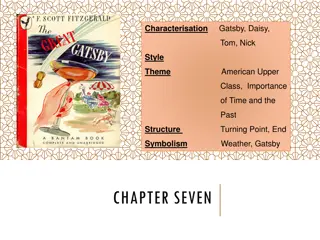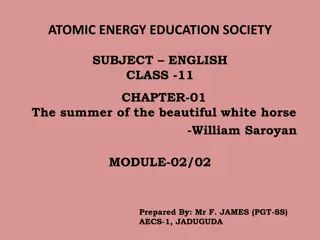Physics 110: Energy Problems and Solutions
This collection of physics problems and solutions covers topics like work done by constant and varying forces, scalar product of vectors, and energy transfer. Examples include calculating work done on blocks by different forces, work done on a raindrop under gravitational and air resistance, and work done by varying forces on particles. Solutions for each problem are provided, offering insights into energy calculations in various scenarios.
Download Presentation

Please find below an Image/Link to download the presentation.
The content on the website is provided AS IS for your information and personal use only. It may not be sold, licensed, or shared on other websites without obtaining consent from the author.If you encounter any issues during the download, it is possible that the publisher has removed the file from their server.
You are allowed to download the files provided on this website for personal or commercial use, subject to the condition that they are used lawfully. All files are the property of their respective owners.
The content on the website is provided AS IS for your information and personal use only. It may not be sold, licensed, or shared on other websites without obtaining consent from the author.
E N D
Presentation Transcript
Phys 110 Chapter 7 Energy and Energy Transfer By Prof. Dr. Bandar Ali Al-Asbahi
PROBLEMS Section 7.2 Work Done by a Constant Force 1. A block of mass 2.50 kg is pushed 2.20 m along a frictionless horizontal table by a constant 16.0-N force directed 25.0 below the horizontal. Determine the work done on the block by (a) the applied force, (b) the normal force exerted by the table, and (c) the gravitational force. (d) Determine the total work done on the block. SOLUTIONS TO PROBLEM: W = F r cos = (16.0 N) (2.20 m) cos 25.0 =31.9 J The normal force and the weight are both at 90 to the displacement in any time interval. Both do 0 work. 2
PROBLEMS Section 7.2 Work Done by a Constant Force 4. A raindrop of mass 3.35 * 10-5 kg falls vertically at constant speed under the influence of gravity and air resistance. Model the drop as a particle. As it falls 100 m, what is the work done on the raindrop (a) by the gravitational force and (b) by air resistance? SOLUTIONS TO PROBLEM: (a) 3.28 10 2 J (b) - 3.28 10 2 J W = mgh Since R = mg Wair resistance =-W 3
PROBLEMS Section 7.3 The Scalar Product of Two Vectors 7. A force F = (6 i - 2 j) N acts on a particle that undergoes a displacement r =(3 i + j) m. Find (a) the work done by the force on the particle and (b) the angle between F and r. SOLUTIONS TO PROBLEM: (a) 16.0 J (b) 36.90 W = F r = Fx x + Fy y = 6.00(3.00) N m+ ( 2.00)(1.00) N m= 16.0 J ? = cos ??. ? ? ? ?? = cos ?( ) ???+ ??? ??+ ?? 4
PROBLEMS Section 7.4 Work Done by a Varying Force 13. A particle is subject to a force Fx that varies with position as in Figure P7.13. Find the work done by the force on the particle as it moves (a) from x = 0 to x = 5.00 m, (b) from x = 5.00 m to x = 10.0 m, and (c) from x = 10.0 m to x = 15.0 m. (d) What is the total work done by the force over the distance x = 0 to x = 15.0 m? SOLUTIONS TO PROBLEM: (a) 7.5 J (b) 15 J (c) 7.5 J (d) 30 J 5
PROBLEMS Section 7.4 Work Done by a Varying Force 14. A force F = (4x i + 3y j) N acts on an object as the object moves in the x direction from the origin to x = 5.00 m. Find the work done on the object by the force. SOLUTIONS TO PROBLEM: Answ.: 50 J ??.??= 0 5?.?? ? W = ? 7
PROBLEMS Section 7.4 Work Done by a Varying Force 15. When a 4.00-kg object is hung vertically on a certain light spring that obeys Hooke s law, the spring stretches 2.50 cm. If the 4.00-kg object is removed, (a) how far will the spring stretch if a 1.50-kg block is hung on it, and (b) how much work must an external agent do to stretch the same spring 4.00 cm from its unstretched position? SOLUTIONS TO PROBLEM: (a) 0.983 cm (b) 1.25 J 8
PROBLEMS Section 7.4 Work Done by a Varying Force 16. An archer pulls his bowstring back 0.400 m by exerting a force that increases uniformly from zero to 230 N. (a) What is the equivalent spring constant of the bow? (b) How much work does the archer do in pulling the bow? SOLUTIONS TO PROBLEM: (a) 575 N/m (b) 46 J W=1/2 kx2 = 46.0 J 9
PROBLEMS Section 7.4 Work Done by a Varying Force 19. If it takes 4.00 J of work to stretch a Hooke s-law spring 10.0 cm from its unstressed length, determine the extra work required to stretch it an additional 10.0 cm. SOLUTIONS TO PROBLEM: Answ.: 12 J 10
PROBLEMS Section 7.4 Work Done by a Varying Force 21. A light spring with spring constant 1 200 N/m is hung from an elevated support. From its lower end a second light spring is hung, which has spring constant 1 800 N/m. An object of mass 1.50 kg is hung at rest from the lower end of the second spring. (a) Find the total extension distance of the pair of springs. (b) Find the effective spring constant of the pair of springs as a system. We describe these springs as in series. SOLUTIONS TO PROBLEM: (a) 2.04 x 10-2 m (b) 720 N/m 11
PROBLEMS Section 7.5 Kinetic Energy and the Work Kinetic Energy Theorem Section 7.6 The Nonisolated System Conservation of Energy 24. A 0.600-kg particle has a speed of 2.00 m/s at point A and kinetic energy of 7.50 J at point B. What is (a) its kinetic energy at A? (b) its speed at B? (c) the total work done on the particle as it moves from A to B? SOLUTIONS TO PROBLEM: (a) 1.2 J (b) 5 m/s (c) 6.3 J 12
PROBLEMS Section 7.5 Kinetic Energy and the Work Kinetic Energy Theorem Section 7.6 The Nonisolated System Conservation of Energy 25. A 0.300-kg ball has a speed of 15.0 m/s. (a) What is its kinetic energy? (b) What If? If its speed were doubled, what would be its kinetic energy? SOLUTIONS TO PROBLEM: 13
PROBLEMS Section 7.5 Kinetic Energy and the Work Kinetic Energy Theorem Section 7.6 The Nonisolated System Conservation of Energy 26. A 3.00-kg object has a velocity (6.00 i - 2.00 j) m/s. (a) What is its kinetic energy at this time? (b) Find the total work done on the object if its velocity changes to (8.00 i + 4.00 j) m/s. SOLUTIONS TO PROBLEM: (a) 60 J (b) 60 J 14
PROBLEMS Section 7.5 Kinetic Energy and the Work Kinetic Energy Theorem Section 7.6 The Nonisolated System Conservation of Energy 28. A 4.00-kg particle is subject to a total force that varies with position as shown in Figure below. The particle starts from rest at x = 0. What is its speed at (a) x = 5.00 m, (b) x = 10.0 m, (c) x= 15.0 m? SOLUTIONS TO PROBLEM: (a) 1.94 m/s (b) 3.35 m/s (c) 3.87 m/s 15
PROBLEMS Section 7.7 Situations Involving Kinetic Friction 31. A 40.0-kg box initially at rest is pushed 5.00 m along a rough, horizontal floor with a constant applied horizontal force of 130 N. If the coefficient of friction between box and floor is 0.300, find (a) the work done by the applied force, (b) the increase in internal energy in the box-floor system due to friction, (c) the work done by the normal force, (d) the work done by the gravitational force, (e) the change in kinetic energy of the box, and (f) the final speed of the box. SOLUTIONS TO PROBLEM: (a) 650 J (b) 588 J (c) 0 (d) 0 (e) 62 J (f) 1.76 m/s 16
PROBLEMS Section 7.7 Situations Involving Kinetic Friction 32. A 2.00-kg block is attached to a spring of force constant 500 N/m as in Figure below. The block is pulled 5.00 cm to the right of equilibrium and released from rest. Find the speed of the block as it passes through equilibrium if (a) the horizontal surface is frictionless and (b) the coefficient of friction between block and surface is 0.350. SOLUTIONS TO PROBLEM: (a) 0.791 m/s (b) 0.531 m/s 18
PROBLEMS Section 7.7 Situations Involving Kinetic Friction 33. A crate of mass 10.0 kg is pulled up a rough incline with an initial speed of 1.50 m/s. The pulling force is 100 N parallel to the incline, which makes an angle of 20.0 with the horizontal. The coefficient of kinetic friction is 0.400, and the crate is pulled 5.00 m. (a) How much work is done by the gravitational force on the crate? (b) Determine the increase in internal energy of the crate incline system due to friction. (c) How much work is done by the 100-N force on the crate? (d) What is the change in kinetic energy of the crate? (e) What is the speed of the crate after being pulled 5.00 m? SOLUTIONS TO PROBLEM: (a) 168 J (b) 184 J (c) 500 J (d) 148 J (e) 5.65 m/s 20
PROBLEMS Section 7.7 Situations Involving Kinetic Friction 35. A sled of mass m is given a kick on a frozen pond. The kick imparts to it an initial speed of 2.00 m/s. The coefficient of kinetic friction between sled and ice is 0.100. Use energy considerations to find the distance the sled moves before it stops. SOLUTIONS TO PROBLEM: Answ.: 2.04 m 22
PROBLEMS Section 7.8 Power 37. A 700-N Marine in basic training climbs a 10.0-m vertical rope at a constant speed in 8.00 s. What is his power output? SOLUTIONS TO PROBLEM: Answ.: 875 W 23
PROBLEMS Section 7.8 Power 40. A 650-kg elevator starts from rest. It moves upward for 3.00 s with constant acceleration until it reaches its cruising speed of 1.75 m/s. (a) What is the average power of the elevator motor during this period? (b) How does this power compare with the motor power when the elevator moves at its cruising speed? SOLUTIONS TO PROBLEM: 24
The End 25























